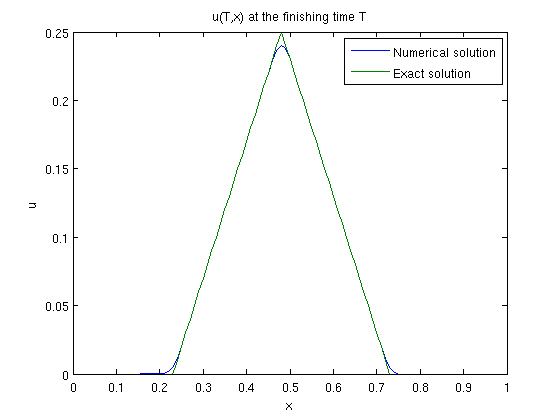%%------------------------------------------------------------------------%% % Solve the one-way wave equation % % % % u_t + a u_x = 0 for 0<x<1, 0<t<T % % % % | 0 for 0<x<0.25 % % u(0,x) = | x-0.25 for 0.25<x<0.5 the initial condition % % | 0.75-x for 0.5<x<0.75 % % | 0 for 0.75<x<1 % % % % u(t,0) = 0 if a>0 the boundary condition % % u(t,1) = 0 if a<0 % % % % In this example, we only use forward space-discretization. % % % % In the beginning, you can set the following values: % % a -- wave speed % % M -- number of space intervals % % k -- time step size % % N -- number of time steps (the final time T = k*N) % % time_discretization = 'forward' or 'backward' % %%------------------------------------------------------------------------%% % First, we need to set some parameters ... a = -0.2; M = 100; k = 1.0/M; N = 10; time_discretization = 'forward'; %time_discretization = 'backward'; % set h and lambda = k/h. % DO NOT change them manually, they should be calculated h = 1.0/M; lambda = k/h; % Now, let's solve the problem using the finite difference method % generate a (N+1)-by-(M+1) matrix to store data u = zeros(N+1,M+1); % set the initial condition x = linspace(0, 1, M+1); % generate a (M+1)-dim vector x for m=1:M+1 if x(m) <= 0.25 u(1,m) = 0.0; elseif x(m) <= 0.5 u(1,m) = x(m)-0.25; elseif x(m) <= 0.75 u(1,m) = 0.75-x(m); else u(1,m) = 0.0; end end %for i % For time step 2 to N, calculate u using the previous time step data. % This process is different for forward/backward time schemes. if isequal(time_discretization,'forward') % forward time for n=2:N+1 for m=1:M u(n,m) = u(n-1,m) - a*lambda*( u(n-1,m+1) - u(n-1,m) ); end % now set the boundary condition if a<0 u(n,M+1) = 0.0; else u(n,M+1) = u(n,M); % in downwind scheme, manually set outflow boundary end end % for t elseif isequal(time_discretization,'backward') % backward time for n=2:N+1 % for backward scheme (implicit), we need to solve % a linear system in each time step. % First, set the linear system ... A = sparse(M+1,M+1); % A is an (M+1)*(M+1) sparse matrix f = zeros(M+1, 1); % f is an (M+1)-dim vector for m=1:M A(m,m) = 1-a*lambda; A(m,m+1) = a*lambda; f(m) = u(n-1,m); end % now set the boundary condition if a<0 % set the last equation u(n,M+1) = 0 A(M+1, M+1) = 1; f(M+1) = 0; else % set the last equation u(n,M+1)-u(n,M) = 0 A(M+1,M+1) = 1; A(M+1, M) = -1; f(M+1) = 0; end % solve the linear system for u(t+1,:), A\f computes A^{-1} f % a single quote will do a tranpose, % which makes the column vector (A\f) into a row vector u(n,:) = (A\f)'; end %for t end %if time_discretization % Next, we should view the results... % print the settings on screen T = N*k; fprintf('The settings are: \n'); fprintf(' k = %f, h = %f, lambda = %f \n',k,h,lambda); fprintf(' After %d time steps, we end at T = %f \n\n', N, T); % draw the solution at t=T % we know the exact solution at t=T is u_0(x-aT) x_minus_at = linspace(0,1,M+1) - a*T; exactsol = zeros(1,M+1); for m=1:M+1 if x_minus_at(m) <= 0.25 exactsol(1,m) = 0.0; elseif x_minus_at(m) <= 0.5 exactsol(1,m) = x_minus_at(m)-0.25; elseif x_minus_at(m) <= 0.75 exactsol(1,m) = 0.75-x_minus_at(m); else exactsol(1,m) = 0.0; end end %for i figure(1); clf; plot(x,u(N+1,:),x,exactsol); legend('Numerical solution','Exact solution'); title('u(T,x) at the finishing time T'); xlabel('x'); ylabel('u'); % draw the suface u(t,x) [x,t] = meshgrid(0:h:1,0:k:(k*N)); figure(2); clf; surf(x,t,u); title('solution u(t,x)'); xlabel('x'); ylabel('t'); zlabel('u');
The settings are:
k = 0.010000, h = 0.010000, lambda = 1.000000
After 10 time steps, we end at T = 0.100000

